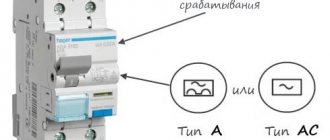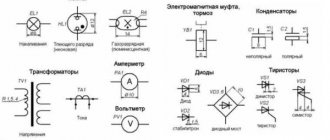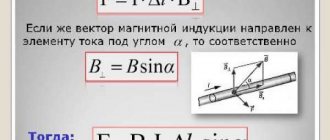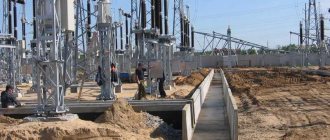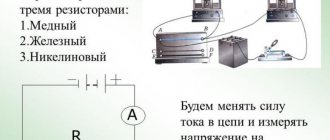This calculator will allow you to calculate the leakage current (aka Rated residual current) at which the RCD should trip. To calculate, enter in the appropriate fields of the form the total power of the devices connected to the RCD, the length of the conductor and select the required network voltage from the list. By clicking the “Calculate” button you will receive the values of the calculated current, the total leakage current and, in fact, the rated leakage current.
A residual current device (RCD) is designed to prevent fires due to damage and aging of wire insulation. When choosing an RCD, the sum of the natural leakage currents of the connected devices should be no more than 1/3 of the rated leakage current. To protect a person from electric shock when contacting parts of electrical installations under voltage, residual current devices must operate at a differential current of no more than 30 mA, since high current values are dangerous to life.
*The leakage current value for selecting an RCD is calculated according to PUE 7, Chapter 7.1.83.
How to calculate an RCD for a house and apartment
To calculate a residual current device (RCD), it is necessary to take into account its operating conditions. In a single-phase electrical network, two-pole devices are used, and in a three-phase electrical network, four-pole devices are used. Since the RCD reacts to leakage currents (Iut), its choice will depend on the length of the conductors, the quality of the insulation, the number of connected devices, devices, and their characteristics. In addition, we must remember that Iut of 30 mA can be dangerous to human life. Therefore, in wet rooms it is necessary to install an RCD.
Classification of protective devices
So that any consumer can correctly determine the model, before choosing an RCD for an apartment from the many proposed modifications in the retail network, experts created a classification based on the following parameters:
- principle shutdown method;
- origin of diphthok;
- time delay for turning off diphtoc;
- structural number of poles;
- installation technology.
Classification by current
The most significant parameters are the method of operation and the type of current. The method, in turn, is divided into two connection options - electromechanical and digital. In the first option, the RCD turns off the power in the emergency area, without connection with the network parameters. The basic operating element is a toroidal core with windings placed. During a leak, voltage is created in the secondary circuit to turn on the polarization relay, which activates the trip mechanism.
You might be interested in Homemade ionistor
Important! All modifications of the implemented residual current devices are grouped according to the load current flowing through them. They are capable of processing the voltage of a specified waveform. The manufacturer indicates the operating voltage on the housings of household units and in the passport data. This value must correspond to the range of rated electric current. The AC option will become activated when an alternating leakage voltage instantly arrives in the controlled electrical circuit or in the event of its wave-like amplification. Such devices are marked “AC” or the symbol “~”.
Leakage current
To ensure safety from electric shock, it is often necessary to increase the number of residual current devices and divide the network into several groups. At the same time, the use of very sensitive RCD devices leads to false alarms. The specialist’s task is to make the correct calculation and choice, taking into account all factors.
According to the rules of electrical installations, when Iut is unknown, it is taken equal to the product of 0.4 mA by the number corresponding to the calculated load current in amperes. The circuit leakage is assumed to be equal to the product of 0.01 mA by the length L of the phase conductor in meters. According to the same rules, the total network losses must be less than one third of the rated residual current of the RCD. This also includes all leaks from constantly switched on and periodically connected electrical appliances. Let's make a calculation.
Total Iut= 0.4* IΣ +0.01*L
It follows that the maximum current of the RCD must be 3 times greater than the total Iout of the network.
Accordingly, the rated breaking current is equal to:
IΔn= 3*(0.4* IΣ +0.01*L), where
IΣ – total leakage current of all electrical installations in the network,
L is the length of the phase wire in meters.
Let's return to the real world. Why there may be false positives
One of the reasons why old-school electricians do not accept RCDs is false alarms. And false alarms (provided that the device is working properly) can only happen for one reason - there is a leak, and it is noticeable. But the reasons for the appearance of leaks are varied:
- Insulation may be broken. If the cable is old and exposed to the sun, then cracks may appear in the insulation. We get it a little wet and we have an unpredictable amount of leakage.
- Normal leak in equipment. Even in working equipment there is a certain amount of leakage, and with alternating current direct contact is not needed, it is enough that one of the conductors made a long loop along the body. The resulting capacitive coupling is sufficient for a small current to flow. A special device can be used to measure the amount of actual leakage in the line with all connected devices. If direct measurement is not available, you can use the rule of thumb (7.1.83 PUE) - assume that for every 1 A of current consumption by the device there will be 0.4 mA of leakage, as well as 10 μA of leakage for each meter of phase conductor length. (The numbers are very average, like the average temperature in a hospital, but at least it’s something). It is desirable that the sum of all leaks in the circuit during normal operation does not exceed 1/3 of the rated value of the disconnecting differential current. Well, as a cherry on the cake - if the RCD says that the differential tripping current is 30 mA, this means that at 30 mA it will definitely turn off. And it definitely won’t turn off at half this current - 15 mA. But with a differential current between these values - depending on your luck. If you have a 30 mA RCD, and a bunch of devices are plugged into sockets, so that the total leakage during normal operation is 20 mA, then a situation is created where the RCD can spontaneously turn off for no apparent reason.
- There is an installation error, and somewhere (for example, in one of the socket boxes) there is a connection between the working neutral conductor N and the grounding conductor PE, or they are mixed up.
Choice for an apartment
For an example of calculation, let's take an apartment in a multi-story building. There is a circuit breaker in the floor panel at the input. Let the machine be 40 Ampere. It protects against short circuits and overloads. A fire protection RCD is installed immediately behind it; we will calculate its nominal value later. It is needed for fire protection in case of cable insulation failure or breakdown. Further, to ensure greater safety and uninterrupted supply of electricity, RCDs with a certain Iout from 10 to 30 mA are installed for each or several groups. Depends on leakage currents. There are even sockets with their own RCD devices. Each consumer group is equipped with its own automatic overload switch.
The bathroom has a washing machine with a power of 1.8 kW. Since it is located in a damp room, for safety we will provide a 16 A circuit breaker and calculate the RCD based on power.
The operating current for a washing machine is:
The length of the phase wire to it is 20 m.
Hence IΔn= 3*(0.4* IΣ +0.01*L)=3(0.4x7.3+0.01x20)=9.36 mA.
The closest RCD in the row is 16 A, leakage current 10 mA.
Let's look at typical schemes. Example 1. Which RCD should I install in my apartment?
In Fig. 2, after the meter, a differential protection is installed as fire protection. The lighting in each room is switched to a separate machine. Differential relays are installed for the most “demanding” rooms - children's rooms, living quarters and bathrooms (SNIP 31-110-2003 clause 14.40). The kitchen electric stove is separated only automatically. This was chosen with the expectation that there are no moving parts in the electric stove and the risk of damage to the insulation in it is minimal. Lighting is also not protected (recommendations of PUE 7.1.79), because Current leaks for lamps are insignificant and do not pose a danger, and, if necessary, can be easily localized.
Calculation of RCD for an apartment. 1st differential relay.
Let's make the calculation for the first
circuit serving consumers connected through sockets. We will assume that the following electrical appliances are working simultaneously:
Refrigerator, with a power of 3500 W with a wiring length of 15 m
Air conditioner, 3450 W, length 10m
Living room sockets 2400 W, 20m
Children's sockets 1500 W, 15m
Other sockets 2500 W, 25 m.
We select the values of the automata. From Table 1 it follows that for the refrigerator and air conditioner you need to choose 6 A machines, for children - 2 A, for others - 3 A. Class of automatic machines is C, as the most common in household electrical wiring. Let's calculate the natural leakage for consumers - (6+2+3x2) x 0.4 = 14 x 0.4 = 5.6 mA. We select the operating current from Table 1 based on a value greater than the total load - 16A.
Rated current
The RCD has another important parameter - the rated current, which must be taken into account in the calculations. When operating within the nominal limits, the device is guaranteed to perform its functions for as long as desired.
Overload protection circuit breakers, which are installed on each power supply group, have a rating of 16, 20, 25, 32 amperes, and so on. But when these values are reached, the device will not turn off. Its characteristics are such that it begins to turn off at values exceeding the nominal value by 1.13-1.45 times, only thanks to the thermal release. It turns off after one to two hours. And for a quick shutdown, it needs to exceed the nominal value from three to fifteen times. This feature of the overload and short circuit protection circuit breaker must be taken into account.
The disconnect device is installed with a rated current always at a level higher . For example, if there is a 32 ampere circuit breaker for overloads and short circuits, then the residual current device should be 40 amperes. Therefore, in the apartment for which the calculation was made, the fire-fighting RCD device will have a rated shutdown current of 100 mA and 63 A, respectively. The washing machine will have a 10 mA/16 A device. For the second lighting group, there will be a device with a limit of 10 mA/25 A. The remaining RCD devices have limits of 30 mA/32 A.
additional characteristics
In addition to these basic characteristics for which calculations are carried out, there are also quantities that require attention when choosing. This is the maximum short circuit current; for a home it is assumed to be 4500 A, for an apartment building 6000 A, for production 10000 A. On the body of the product it is depicted as a number surrounded by a frame. The type of disconnecting leakage current is indicated by letters:
- AC means it is variable;
- A – IΔn variable and pulsating constant;
- B – IΔn variable and constant;
- S – selective, turns off with a delay.
RCD type AC is used in apartments. Common consumers - lighting, refrigerators, heated floors. The maximum shutdown time for this type of RCD is 0.04-0.3 seconds, depending on the magnitude of the leakage current.
Type A is used where there are many devices with rectifiers and switching power supplies: computers, washing machines, televisions, dishwashers, microwave ovens. Sometimes manufacturers directly indicate that there should be an RCD A device, and then a current calculation is performed.
Type B is used mainly in industry, requiring detailed calculations before installation.
Type S (selective). The response time of such an RCD is 0.2-0.5 seconds, so it is not protective for humans. The device is installed at the beginning of the line after the main circuit breaker and is the second stage of differential protection of the entire facility from fire.
In addition, you need to determine which residual current device to choose: electromechanical or electronic. The first is more reliable, but also more expensive. The second type is cheaper than electromechanical, but its electronic components more often burn out under all kinds of overloads.
When organizing an electrical network protection system, it is necessary to take into account that more than 5 circuit breakers cannot be connected to one RCD. This may lead to false positives. In addition, with proper shutdown, it is impossible to understand where the leak occurred.
What does the RCCB (RCD) trigger?
The RCCB is absolutely useless, how did it happen that the currents in its phase and neutral wires began to differ critically. So critical that he decides to turn off the load, which does not comply with the 1st law of old Kirchhoff.
Differential current is evil. He speaks either of poor insulation (this is acceptable to some extent), or of some kind of emergency incident that can lead to a fire and casualties. And against him, the same Germans came up with a VDT, which traders and normal electricians call an RCD.
And to speak correctly, the RCCB operates precisely on differential current.
It turns out that if a person says with a smart look, “The RCD was triggered by a leak,” then:
- A long line and many devices were connected to the VDT. At the same time, everything is absolutely correct and normal,
- the person did not read my article, and confuses leakage current and differential current,
- this man is a plumber whose pipes burst, water spilled onto the VDT with all the ensuing consequences...
Calculation and selection of RCD
The Residual Disconnection Device (RCD), depending on the rated leakage current, provides protection: 100 and 300 mA - from fire; 30 mA - from fire and life from shock; 10 mA - life from electric shock
Research from around the world shows that the severity of an electric shock is determined by the strength of the current passing through a person's body.
Personal injury becomes serious when the current exceeds 40 to 50 mA for one second.
Theoretically, the current flowing through the human body reaches 150 mA when a person touches a 230 V conductor in a dry environment.
By measuring the difference in current between the live conductor and the neutral conductor, the load differential switch actually detects the current flowing through the human body. If this current reaches a threshold of 30 mA, the load differential switch opens within a few milliseconds, thus preventing bodily injury or worse consequences. .
What is earth fault current?
This is any current that flows from a phase (linear) conductor to any objects that are in one way or another connected (having an electrical connection) to the solidly grounded neutral of the transformer at the substation (TS). What is the difference from leakage current? The fundamental difference is that ground fault current occurs in an emergency
.
This is my free statement.
And here is what GOST IEC 61008-1-2020
(clause 3.1.1),
ground fault current is
“the current passing into the ground through the fault point when the insulation is damaged.”
When insulation breaks down, for example, on the metal body of an electrical appliance, a certain amount of ground fault current appears. The magnitude of this current can “walk” within very large limits - from a few milliamps (for example, with increasing humidity) to hundreds and thousands of amperes (with a short circuit).
It is strange and incomprehensible why the same GOST contains the words: “RCCBs can be used to protect against fire caused by current leakage through worn wire insulation and poor-quality connections.” Or is “leakage current” different from “leakage current”? The answer is simple - “leakage current” is a parameter of the electrical installation, and “current leakage” is a physical phenomenon.
In the picture I depicted the ground fault current in the form of lightning:
Ground fault current
Many electricians and their sympathizers have a strong opinion (stereotype) that a ground fault always results in sparks, knocking out machines and other dislikes. But that's not true. In some cases, even a current of 1 mA can be considered a ground fault current.
Theoretically, the ground fault current can reach the value of the short circuit current. Read my article - What is short-circuit current and what does it depend on.
But a ground fault is not just about insulation. If a person comes into direct contact with exposed conductive parts (a phase wire or any other metal part of an electrical installation that is energized for some reason), and the person is on a conductive surface, then a ground fault current will pass through his body. What current value will be in this case and what it will lead to depends on the human factor (black humor). At best, a person will not even feel anything and will not understand that cases are different.
Once again, what is the difference between leakage current and fault current? A leak is normal, a short circuit is an accident. The limit in this case is determined by measuring the insulation resistance - as soon as it drops to an unacceptable level, the leak will miraculously become a short circuit.
Much like if you look at a spy from the other side, he will become an intelligence officer.
Main characteristics for selecting RCDs
Let's consider a number of important characteristics for choosing an RCD. There are devices;
— for single-phase and three-phase electrical networks 220/380 V; - two-pole RCD for 220 V network and four-pole for 380 V; — the value of the rated current of the RCD for different loads is 10, 16, 25, 32, 40, 63, 80. 100 A; - the value of the differential current or leakage current of the differential switch at 6, 10, 30, 100, 300 and 500 mA;
Two-pole and four-pole RCD
Type of differential current;
— A for alternating current; — AC ability to operate RCDs on alternating and non-rectified direct current; — B for protection operation on alternating and direct current; — S operation of an RCD with a time delay; — G work with a time delay shorter than type S devices.
Also, the residual current device has the same characteristics as the automatic circuit breaker.
- "Inc" The value of the short circuit current when the device is turned off indicates the reliability and resistance to short circuits.
- “Im” Switching capacity of failure-free operation of the contact group.
Values of 1000-5000 A are considered good indicators.
How to choose the right RCD
The differential device can be electronic or electromechanical. The electromechanical version has a toroidal differential transformer and an actuator in the form of a polarized relay. Electronic differential devices have an electronic board that operates from the mains voltage.
Since our electrical network has not yet reached good quality (voltage surges, frequent shutdowns, under or over voltage), the electronic board of the device may fail. The recommended option is a more reliable electromechanical device; it does not require a power source.
When choosing an RCD, it is also important to take into account the leakage currents in the electrical devices themselves. All electrical appliances have their own current leakage, the magnitude of which depends on their quality of performance. The leakage current value is usually indicated in the characteristics of the device. These values should not exceed 30% of the residual current leakage value. For example, for a leakage current of 30 mA, the amount of leakage current from electrical appliances should not be more than 10 mA.
When choosing differential protection, this must be taken into account, otherwise there will be frequent false network shutdowns. Our electrical network voltage has a sinusoidal shape, so the protective switch is chosen as AC or A for alternating voltage.
How to choose an RCD for an apartment
Before installing protection in an apartment, the rated current of the input circuit breaker is calculated and then a two-pole protection with a rated current an order of magnitude or two higher than the current of the input circuit breaker is selected. Let’s say your input circuit breaker is 25 A, then the rated protection current is selected as 32 A.
Basic parameters on the RCD body for selection
A device current of less than 30 mA should not be selected, since the sum of leakages of all consumers can be quite high and the protection will give false alarms.
Importance of the event
If you choose the wrong RCD model, that is, make a mistake with its characteristics, this is fraught with the following consequences:
- The automation will be triggered during a false alarm, because... minor electrical leaks are always present in the wiring, especially if it is old (in a wooden house in the country).
- The overly high power rating of the RCD you choose will not operate during a dangerous situation, resulting in an electric shock.
- The device will not be able to function when connecting the aluminum conductors of your home wiring, since most modern models are designed only for connecting copper conductors.
To prevent these errors, you first need to understand the characteristics of the differential switch, and then proceed to its selection.
How to choose an RCD for a private house
When connecting a three-phase network to houses, four-pole differential protection is installed. The electrical panel is installed on the first floor, type “S” protection is installed with a delay time and a leakage current value of 100 mA. From the input machine, power lines are distributed across floors, rooms, kitchens, and bathrooms.
For individual rooms, protection should not exceed a leakage current of 30 mA. If the wiring has already served its useful life, then there is a possibility of frequent false alarms of the device. Here it is recommended to install an RCD built into the socket.
Interesting articles too
How to connect a circuit breaker
RCD check. RCD testing methods
Connection diagram for differential machine
Calculation of machine power
This online calculator allows you to select an RCD by calculating its rated current and leakage current by power and length of the electrical network. (For more information about the principle of operation, connection diagrams and characteristics of the RCD, see the article: RCD).
IMPORTANT: For protection against electric shock, RCDs with a differential current of no more than 30 mA , differential currents: 100, 300 and 500 mA are used for protection against fires (such RCDs can be installed in the input panel together with a general protection device). If an RCD is needed to protect against electric shock, and according to the calculation, the leakage current is more than 30 mA, it is necessary to provide for the installation of several RCDs on different groups of lines, for example, one RCD to protect sockets in rooms, and a second to protect sockets in the kitchen, thereby reducing the most power passing through each RCD and, as a result, reducing the network leakage current, i.e. in this case, the calculation will need to be made for two or more RCDs that will be installed on different lines.
Instructions for using the RCD calculator:
- We select the calculation method: Simplified - the leakage current of the RCD is determined based on its purpose (type of protected electrical network); Professional - calculation of RCD leakage currents is made based on the calculated current of the electrical network and its total length.
- We select the purpose of the RCD: General protection of the household electrical network - if the calculation is made for an RCD that will be installed in the incoming electrical panel of the house and will provide general protection of the entire electrical network; Protection of particularly dangerous premises - if the calculation is made for an RCD providing general protection of the electrical network in particularly dangerous premises, for example in a bathhouse, sauna, bathroom, shower, etc.; Protection of a separate electrical receiver - if the calculation is made for an RCD that provides protection for a separate electrical receiver, for example: a washing machine, dishwasher, boiler, etc.
- We indicate the power of the electrical network in kilowatts (1 kilowatt = 1000 watts) , and select the type of specified power: “ Maximum power allowed for use ” - if the power is taken from the project (technical conditions) for the house (apartment) or from the electricity supply contract; “ Total power of all electrical appliances that will be connected to the electrical network” - if the specified power was obtained by summing the power of all electrical equipment in the house (apartment); “ Power of a specific electrical appliance ” - if the specified power refers to one electrical receiver that will protect the calculated RCD (for example, the power of a washing machine if a separate RCD is installed on it), or the total power of a group of electrical receivers that are switched on simultaneously.
- We select a network voltage of 220 Volts for a single-phase network, or 380 Volts for a three-phase network.
- Enter the length of the electrical network (all its sections connected to the RCD being calculated) in meters - The length must be entered only with a professional calculation method.
- Click the “CALCULATE” button
As a result of the calculation, we obtain the required standard values of the rated current and differential current (leakage current) of the RCD, which can provide reliable protection for your electrical network.
Did you find this online calculator useful? Or maybe you still have questions ? Write to us in the comments!
Didn’t find an article on the website on a topic that interests you regarding electrical engineering? Write to us here. We will definitely answer you.
I died. Why didn’t the RCD save you?
RCD is not a panacea, but nothing better has yet been invented. If you hold the phase conductor with one hand and the neutral conductor with the other hand, then for the electrical network you will be just another heater, the differential current will not appear and the RCD will not work. Also, if you put your finger into the lamp socket, current will flow through the finger, but there will be no leakage into the ground, and the RCD will not turn off. Therefore, even the presence of such protection does not mean that you can lose vigilance and caution. An experienced electrician doesn’t even grab his wife’s two breasts at the same time 
